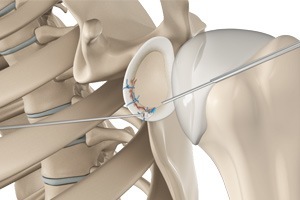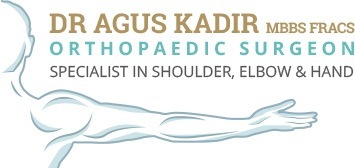Arthroscopic Stabilization of Shoulder

Arthroscopic stabilization is a surgical procedure to treat chronic instability of shoulder joint. The shoulder is the most flexible joint in our body making it more susceptible to instability and injury. Shoulder instability occurs when the head of the humerus (upper arm bone) dislocates from its socket (the glenoid) as a result of a sudden injury or overuse. The repeated dislocation of the humerus out of its socket is called chronic shoulder instability. A tear in the labrum or rotator cuff and ligament tear in the front of the shoulder (a Bankart lesion) may lead to repeated shoulder dislocations. Shoulder instability is often treated by the technique called stabilization and can be performed arthroscopically.
Arthroscopy is a minimally invasive surgery and is performed through two tiny incisions (portals), about half-inch in length made around the joint area. Through one of the incisions, arthroscope (small fibre-optic viewing instrument) is passed. A television camera attached to the arthroscope displays the images of the inside of the joint on the television monitor, which allows your surgeon to look at the cartilage, ligaments and the rotator cuff while performing the procedure. A sterile saline solution is pumped into the joint which expands it and gives a clearer view to the surgeon. Bone spurs, defects or tissue tears will be identified.
Your surgeon makes use of tiny surgical instruments which are passed through the other incision to treat the condition. Any tear in the rotator cuff will be sutured or stapled. The sutures will be held in place with help of a small anchor which is drilled into the upper part of the humerus. Further, a thermal shrinkage device may be used in order to make the ligaments tight and prevent instability.
Following the procedure, your surgeon may advise use of a continuous passive motion machine to prevent stiffness and improve range of motion of the shoulder joint. Pain medications will be prescribed to keep you comfortable. A shoulder sling can be worn for 4-6 weeks to immobilize and facilitate healing. Post-operative rehabilitation program including strengthening exercises will be advised for 6-9 months. You will be able to participate in sports in between 18 and 36 weeks after the surgery.
The major benefits of arthroscopic stabilization as compared to open repair of instability are that it gives a chance to identify and treat coexisting diseases, lesser pain and complications, combined with shorter hospital stay.
As with any surgical procedure, there may be certain risks and complications involved and include infection of the surgical wound, post-operative stiffness, risk of arthritis, muscle weakness and injury to the nerves and blood vessels.

 Menu
Menu






